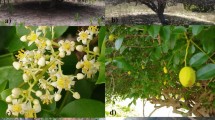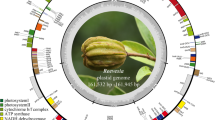Abstract
Genetic variation of nuclear ribosomal ITS (nrITS) and chloroplast DNA (cpDNA) regions was investigated in Brasenia schreberi (Cabombaceae) to assess the population structure and to infer the evolutionary relationship among 12 populations distributed in South Korea. The combined sequence of the two regions was aligned to 2,069 bp, of which 28 sites were variable. In total, 20 genotypes were identified from 240 individuals of B. schreberi. Genotype diversity (Gd) and nucleotide diversity (Pi) on Jeju Island (Gd = 0.2511, Pi = 0.00012) were higher than those of the mainland of South Korea (Gd = 0.1358, Pi = 0.00005). The relatively low level of genetic variation of the mainland populations is associated with its higher genetic differentiation (G ST = 0.095 on mainland and 0.039 on Jeju Island) and human activities. Minimum spanning network analysis demonstrated that the investigated populations of B. schreberi were subdivided into two geographical groups: the mainland of South Korea and Jeju Island. In addition, analysis of molecular variation showed that a large proportion (73.55%) of genetic differentiation existed between the two regions. These results strongly suggest the presence of significant barriers to gene flow between regions. Thus, the management unit for B. schreberi should be carefully designed to avoid the potential risk that can results from the admixture of individuals from the mainland and Jeju Island regions.


Similar content being viewed by others
References
Abrahamson WG (1980) Demography and vegetative reproduction. In: Solbrig OT (ed) Demography and evolution in plant populations. Blackwell Scientific Publications, Oxford, pp 89–106
Aston HI (1977) Aquatic plants of Australia. Melbourne University Press, Australia, pp 46–48
Bandelet HJ, Forster P, Rohi A (1999) Median joining network for inferring intraspecific phylogenies. Mol Biol Evol 16:37–48
Chen D-H, Ronald PC (1999) A rapid DNA minipreparation method suitable for AFLP and other PCR applications. Plant Mol Biol Rep 17:53–57
Chen J-M, Liu F, Gituru WR, Wang Q-F (2008a) Chloroplast DNA phylogeography of the Chinese endemic alpine quillwort Isoetes hypsophila Hand.-Mazz. (Isoetaceae). Int J Plant Sci 169:792–798
Chen Y-Y, Li X-L, Yin L-Y, Li W (2008b) Genetic diversity of the threatened aquatic plant Ottelia alismoides in Yangtze River. Aquat Bot 88:10–16
Chiang TY, Chiang YC, Chen YJ, Chou CH, Havanond S, Hong TN, Huang S (2001) Phylogeography of Kandelia candel in East Asiatic mangroves based on nucleotide variation of chloroplast and mitochondrial DNAs. Mol Ecol 10:2697–2710
Choi H-K (2007) Cabombaceae Rich ex A Rich. In The Genera of Vascular Plants of Korea, Academy Publishing Press, Seoul, p 163
Chrysler MA (1938) The winter buds of Brasenia. Bull Torrey Bot Club 65:277–283
Cook CDK (1996) Aquatic and wetland plants of India. Oxford University Press, NY
Crandall KA, Templeton AR (1993) Empirical tests of some predictions from coalescent theory with applications to intraspecific phylogeny reconstruction. Genetics 134:959–969
Elakovich SD, Wooten JW (1987) An examination of the phytotoxicity of the water shield, Brasenia schreberi. J Chem Ecol 13:1935–1940
Excoffier L, Laval G, Schneider S (2005) Arlequin: an integrated software for population genetics data analysis. Ver. 3.0. Evol Bioinforma Online 1:47–50
Farris JS, Kallersjo M, Kluge AG (1995) Testing significance of incongruence. Cladistics 5:417–419
Fischer M, Husi R, Prati D, Peintinger M, Kleunen M, Schmid B (2000) RAPD variation among and within small and large populations of the rare clonal plant Ranunculus reptans (Ranunculaceae). Am J Bot 87:1128–1137
Frankham R (1996) Relationship of genetic variation to population size in wildlife. Conserv Biol 10:1500–1508
Frankham R (1997) Do island populations have less genetic variation than mainland populations? Heredity 78:311–327
Fu YX, Li WH (1993) Statistical tests of neutrality of mutations. Genetics 133:693–709
Futuyma DJ (2009) Evolution, 2nd edn. Sinauer, Sunderland, Massachusetts, pp 255–277
Honjoa M, Uenob S, Tsumurab Y, Washitanic I, Ohsawaa R (2004) Phylogeographic study based on intraspecific sequence variation of chloroplast DNA for the conservation of genetic diversity in the Japanese endangered species Primula sieboldii. Biol Conserv 120:211–220
Huang J-C, Wang W-K, Ping C-I, Chiang T-Y (2005) Phylogeography and conservation genetics of Hygrophila pogonocalyx (Acanthaceae) based on atpB-rbcL noncoding spacer cpDNA. J Plant Res 118:1–11
Jiang JZ, Cao BS (2008) Varieties of aquatic vegetables and their utilization in China. Acta Hortic 769:77–82
Kim Y-D (1996) Characterization of water and sediment environment in water shield (Brasenia schreberi) habitats. Kor J Ecol 19:209–216
Kim C, Na HR, Choi H-K (2008) Conservation genetics of endangered Brasenia schreberi based on RAPD and AFLP markers. J Plant Biol 51:260–268
Koga K, Kadono Y, Setoguchi H (2007) The genetic structure of populations of the vulnerable aquatic macrophyte Ranunculus nipponicus (Ranunculaceae). J Plant Res 120:167–174
Koga K, Kadono Y, Setoguchi H (2009) Phylogeography of Japanese water crowfoot based on chloroplast DNA haplotypes. Aquat Bot 89:1–8
Kunii H (1993) Rhizome longevity in two floating-leaved aquatic macrophytes, Nymphaea tetragona and Brasenia schreberi. J Aquat Plant Manag 31:94–98
Li Y, Li Y, Yang P, He S (2011) Population genetic structure and gene flow of Forsythia suspense (Oleaceae) in Henan revealed by nuclear and chloroplast DNA. Afr J Biotechnol 10:5109–5117
Liu G-H, Zhou J, Li W, Cheng Y (2005) The seed bank in a subtropical freshwater marsh: implications for wetland restoration. Aquat Bot 81:1–11
Lu S-Y, Hong K-H, Liu S-L, Cheng Y-P, Wu W-L, Chiang T-Y (2002) Genetic variation and population differentiation of Michelia formosana (Magnoliaceae) based on cpDNA variation and RAPD fingerprints: relevance to post-Pleistocene recolonization. J Plant Res 115:203–216
Maki M, Morita H (1998) Genetic diversity in island and mainland populations of Aster spathulifolius (Asteraceae). Int J Plant Sci 159:148–152
Nei M (1973) Analysis of gene diversity in subdivided populations. Proc Nat Acad Sci U S A 70:3321–3323
Nei M (1987) Molecular evolutionary genetics. Columbia University Press, NY
Nei M, Tajima F (1983) Maximum likelihood estimation of the number of nucleotide substitutions from restriction site data. Genetics 105:207–217
Oh MJ, Na HR, Choi H-K, Liu JR, Kim SW (2008) High frequency plant regeneration from zygotic-embryo-derived embryogenic cell suspension cultures of watershield (Brasenia schreberi). Plant Biotechnol Rep 2:87–92
Osborn JM, Schneider EL (1988) Morphological studies of the Nymphaeaceae sensu lato XVI. The floral biology of Brasenia schreberi. Ann Mo Bot Gard 75:778–794
Palsboll PJ, Berube M, Allendorf FW (2007) Identification of management units using population genetic data. Trends Ecol Evol 22:11–16
Rousseau-Gueutin M, Gaston A, Ainouche A, Ainouche ML, Olbricht K, Staudt G, Richard L, Denoyes-Rothan B (2009) Tracking the evolutionary history of polyploidy in Fragaria L. (strawberry): new insights from phylogenetic analyses of low-copy nuclear genes. Mol Phylogen Evol 51:515–530
Rozas J, Sanchez-Delbarrio JC, Messeguer X, Rozas R (2003) DnaSP, DNA polymorphism analyses by the coalescent and other methods. Ver. 4.20. Bioinformatics 19:2496–2497
Schwartz MK, Luikart G, Waples RS (2007) Genetic monitoring as a promising tool for conservation and management. Trends Ecol Evol 22:25–33
Soltis PS, Gitzendanner MA (1999) Molecular systematic and the conservation of rare species. Conserv Biol 13:471–483
Su Y-J, Wang T, Zheng B, Jiang Y, Chen G-P, Ouyang P-Y, Sun Y-F (2005) Genetic differentiation of relictural populations of Alsophila spinulosa in southern China inferred from cpDNA trnL-F noncoding sequences. Mol Phylogenet Evol 34:323–333
Swofford DL (2002) PAUP*: Phylogenetic analysis using parsimony (*and other methods). Ver. 4.0b10. Sinauer Associates Inc., Sunderland MA
Tajima F (1989) Statistical method for testing the neutral mutation hypothesis by DNA polymorphism. Genetics 123:585–595
Tamura K, Dudley J, Nei M, Kumar S (2007) MEGA4: molecular evolutionary genetic analysis (MEGA) software. Ver.4.0. Mol Biol Evol 24:1596–1599
Tan B, Liu K, Yue X-L, Liu F, Chen J-M, Wang Q-F (2008) Chloroplast DNA variation and phylogeographic patterns in the Chinese endemic marsh herb Sagittaria potamogetifolia. Aquat Bot 89:372–378
Thompson JD, Gibson TJ, Plewniak F, Jeanmougin F, Higgins DG (1997) The Clustal X windows interface: flexible strategies for multiple sequences alignment aided by quality analysis tools. Nucleic Acids Res 24:4876–4882
Walker GF, Metcalf AE (2008) Genetic variation in the endangered Astragalus jaegerianus (Fabaceae, Papilionoideae): a geographically restricted species. Bull Southern California Acad Sci 177:158–177
Wang X, Chen J (1994) A survey on the habitats of rare and endangered aquatic plants in Hunan Province. Biodiv Sci 2:193–198
White TJ, Birns T, Lee S, Taylor J (1990) Amplification and direct sequencing of fungal ribosomal RNA genes for phylogenetics. In: Innis MA, Gelfand DH, Sninsky JJ, White TJ (eds) PCR protocols: a guide to methods and applications. Academic, San Diego, pp 315–322
Xue J, Zhuo L, Zhou S (2006) Genetic diversity and geographic pattern of wild lotus (Nelumbo nucifera) in Heilongjiang Province. Chin Sci Bull 51:421–432
Zurawski G, Clegg MT (1987) Evolution of higher-plant chloroplast DNA-encoded genes: implications for structure-function and phylogenetic studies. Annu Rev Plant Physiol 38:391–418
Acknowledgments
We thank the anonymous reviewers for their critical comments and suggestions. This work was supported by the Program for Collection, Management, and Utilization of Biological Resources (M10867010003) from the Ministry of Education, Science, and Technology (MEST) of the Republic of Korea.
Author information
Authors and Affiliations
Corresponding author
Appendices
Appendix 1
Collection sites and haplotype distributions of B. schreberi in South Korea. Pie charts show the proportions of genotypes within each population. See Appendix for the frequency of genotypes within each population. Population abbreviations are given in Table 1.

Appendix 2
Rights and permissions
About this article
Cite this article
Kim, C., Jung, J., Na, H.R. et al. Population Genetic Structure of the Endangered Brasenia schreberi in South Korea Based on Nuclear Ribosomal Spacer and Chloroplast DNA Sequences. J. Plant Biol. 55, 81–91 (2012). https://doi.org/10.1007/s12374-011-9193-4
Received:
Revised:
Accepted:
Published:
Issue Date:
DOI: https://doi.org/10.1007/s12374-011-9193-4




